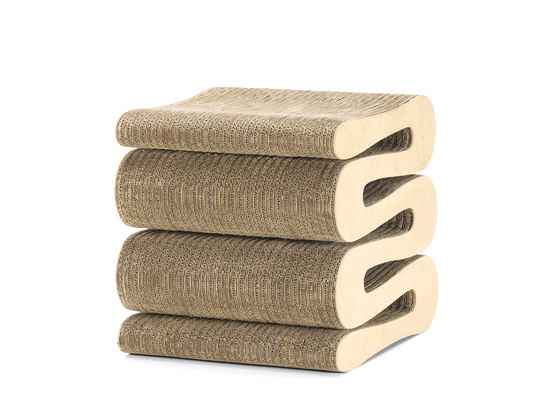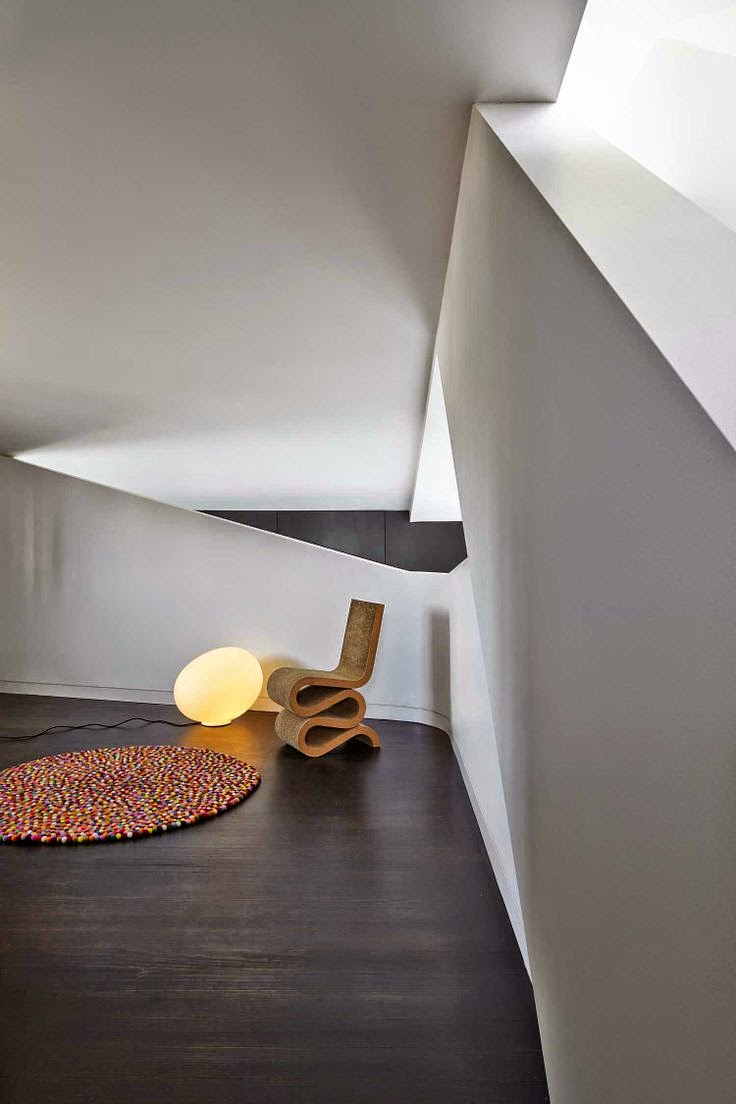WIGGLE CHAIR & STOOL DESIGN BY FRANK O. GEHRY
WIGGLE CHAIR
& STOOL DESIGN BY FRANK O. GEHRY 1972
Size: 85 x 42.5 x 60; Seat Height 45.5 cms
Material: corrugated cardboard, fiberboard, round timber
Cardboard furniture came on the scene during the sixties as a cheap and light alternative to traditional furniture. At that time attempts were made to reinforce the support of the single-layer cardboard offered by using folds, tabs, slots, and other devices. Nevertheless, cardboard was not able to compete against plastic, which was just as light. Frank O. Gehry discovered a process that ensured cardboard furniture-making a new burst of popularity. “One day I saw a pile of corrugated cardboard outside of my office – the material which I prefer for building architecture models – and I began to play with it, to glue it together and to cut it into shapes with a hand saw and a pocket knife.”1 It was thus possible to transform massive blocks of cardboard into cardboard sculptures.
Gehry named this material Edge Board: it consisted of glued layers of corrugated cardboard running in alternating directions, and in 1972 he introduced a series of cardboard furniture under the name “Easy Edges.” The “Easy Edges” were extraordinarily sturdy, and due to their surface quality, had a noise-reducing effect in a room. The design theorist Victor Papanek, one of the first to address the ecological responsibility of designers, praised Edge Board as a useful application of a packing material to furniture. The “Easy Edges” were a great success and brought Gehry overnight fame as a furniture designer, but at the same time he was into a role he did not like. Even sales prices were no longer consistent with Gehry’s basic idea of offering furniture to suit anyone’s pocketbook. “ I started to feel threatened. I closed myself off for weeks at a time in a room to rethink my life. I decided that I was an architect, not a furniture designer … and I simply stopped doing it.”2 Gehry made an international breakthrough as an architect in the late seventies, among other things with the design of his private residence in Santa Monica, California, in 1978. Since 1986 Vitra AG has reproduced four models of his “Easy Edges.” MK
Size: 85 x 42.5 x 60; Seat Height 45.5 cms
Material: corrugated cardboard, fiberboard, round timber
Cardboard furniture came on the scene during the sixties as a cheap and light alternative to traditional furniture. At that time attempts were made to reinforce the support of the single-layer cardboard offered by using folds, tabs, slots, and other devices. Nevertheless, cardboard was not able to compete against plastic, which was just as light. Frank O. Gehry discovered a process that ensured cardboard furniture-making a new burst of popularity. “One day I saw a pile of corrugated cardboard outside of my office – the material which I prefer for building architecture models – and I began to play with it, to glue it together and to cut it into shapes with a hand saw and a pocket knife.”1 It was thus possible to transform massive blocks of cardboard into cardboard sculptures.
Gehry named this material Edge Board: it consisted of glued layers of corrugated cardboard running in alternating directions, and in 1972 he introduced a series of cardboard furniture under the name “Easy Edges.” The “Easy Edges” were extraordinarily sturdy, and due to their surface quality, had a noise-reducing effect in a room. The design theorist Victor Papanek, one of the first to address the ecological responsibility of designers, praised Edge Board as a useful application of a packing material to furniture. The “Easy Edges” were a great success and brought Gehry overnight fame as a furniture designer, but at the same time he was into a role he did not like. Even sales prices were no longer consistent with Gehry’s basic idea of offering furniture to suit anyone’s pocketbook. “ I started to feel threatened. I closed myself off for weeks at a time in a room to rethink my life. I decided that I was an architect, not a furniture designer … and I simply stopped doing it.”2 Gehry made an international breakthrough as an architect in the late seventies, among other things with the design of his private residence in Santa Monica, California, in 1978. Since 1986 Vitra AG has reproduced four models of his “Easy Edges.” MK
You may visit
Frank Gehry’s latest project of Louis Vouitton Fondation
and design Emeco Tuyomyo Bench from my blog archive to click below links.
http://mymagicalattic.blogspot.com.tr/2014/08/louis-vuitton-fondation-design-by-frank.html
B
FRANK O. GEHRY
Frank Gehry considers the recently commissioned Walt Disney Concert
Hall in Los Angeles to be his first major project in his hometown. No stranger
to music, he has a long association with the Los Angeles Philharmonic
Orchestra, having worked to improve the acoustics of the Hollywood Bowl. He
also designed the Concord Amphitheatre in northern California, and yet another
much earlier in his career in Columbia, Maryland, the Merriweather Post
Pavilion of Music.
The Museum of Contemporary Art selected him to convert an old
warehouse into its Temporary Contemporary (1983) exhibition space while the
permanent museum was being built. It has received high praise, and remains in
use today. On a much smaller scale, but equally as effective, Gehry remodeled
what was once an ice warehouse in Santa Monica, adding some other buildings to
the site, into a combination art museum / retail and office complex.
The belief that "architecture is art" has been a part of
Frank Gehry's being for as long as he can remember. In fact, when asked if he
had any mentors or idols in the history of architecture, his reply was to pick
up a Brancusi photograph on his desk, saying, "Actually, I tend to think
more in terms of artists like this. He has had more influence on my
work than most architects. In fact, someone suggested that my skyscraper that
won a New York competition looked like a Brancusi sculpture. I could name Alvar
Aalto from the architecture world as someone for whom I have great respect, and
of course, Philip Johnson."
Born in Canada in 1929, Gehry is today a naturalized U.S. citizen.
In 1954, he graduated from the University of Southern California and began
working full time with Victor Gruen Associates, where he had been apprenticing
part-time while still in school. After a year in the army, he was admitted to
Harvard Graduate School of Design to study urban planning. When he returned to
Los Angeles, he briefly worked for Pereira and Luckman, and then rejoined Gruen
where he stayed until 1960.
In 1961, Gehry and family, which by now included two daughters,
moved to Paris where he worked in the office of Andre Remondet. His French
education in Canada was an enormous help. During that year of living in Europe,
he studied works by LeCorbusier, Balthasar Neumann, and was attracted to the
French Roman churches. In 1962, he returned to Los Angeles and set up his own
firm.
A project in 1979 illustrates his use of chain-link fencing in the
construction of the Cabrillo Marine Museum, a 20,000 square foot compound of
buildings that he "laced together" with chain-link fencing. These
"shadow structures" as Gehry calls them, bind together the parts of
the museum.
Santa Monica Place, begun in 1973, has one outside wall that is
nearly 300 feet long, six stories tall and hung with a curtain of chain link; a
second layer over it in a different color spells out the name of the mall.
For a time, Gehry's work used "unfinished" qualities as a
part of the design. As Paul Goldberger, New York Times Architecture
Critic described it, "Mr. Gehry's architecture is known for its reliance
on harsh, unfinished materials and its juxtaposition of simple, almost primal,
geometric forms...(His) work is vastly more intelligent and controlled than it
sounds to the uninitiated; he is an architect of immense gifts who dances on
the line separating architecture from art but who manages never to let himself
fall."
A guesthouse he designed in 1983 for a home in Wayzata, Minnesota
that had been designed by Philip Johnson in 1952 proved a challenge that
critics agree Gehry met and conquered. The guesthouse is actually a grouping of
one-room buildings that appear as a collection of sculptural pieces.
In 1988, he did a monument to mark the centennial of the Sheet
Metal Workers' International Association. It was built by 600 volunteers from
the union in the cavernous central hall of the National Building Museum
(formerly known as the Pension Building) in Washington, D.C. The 65-foot high
construction was galvanized stainless steel, anodized aluminum, brass and
copper.
There is an interesting note regarding a statement Gehry prepared
for the 1980 edition of Contemporary Architects ,
Gehry states, "I approach each building as a sculptural object, a spatial
container, a space with light and air, a response to context and
appropriateness of feeling and spirit. To this container, this sculpture, the
user brings his baggage, his program, and interacts with it to accommodate his
needs. If he can't do that, I've failed."
B
GEHRY PARTNERS
Gehry Partners, LLP is a full service firm with broad international
experience in academic, commercial, museum, performance, and residential projects.
Frank Gehry established his practice in Los Angeles, California in
1962. The Gehry partnership, Gehry Partners, LLP, was formed in 2001. Gehry
Partners employs a large number of senior architects who have extensive
experience in the technical development of building systems and construction
documents, and who are highly qualified in the management of complex projects.
Every project undertaken by Gehry Partners is designed personally
and directly by Frank Gehry. All of the resources of the firm and the extensive
experience of the firm’s partners are available to assist in the design effort
and to carry this effort forward through technical development and construction
administration. The firm relies on the use of Digital Project, a sophisticated
3D computer modeling program originally created for use by the aerospace
industry, to thoroughly document designs and to rationalize the bidding,
fabrication, and construction processes.
The partners in Gehry Partners, LLP are: Frank Gehry, Brian Aamoth,
John Bowers, Anand Devarajan, Jennifer Ehrman, Berta Gehry, Meaghan Lloyd,
David Nam, Tensho Takemori, Laurence Tighe & Craig Webb.
http://www.foga.com/


.png)



















